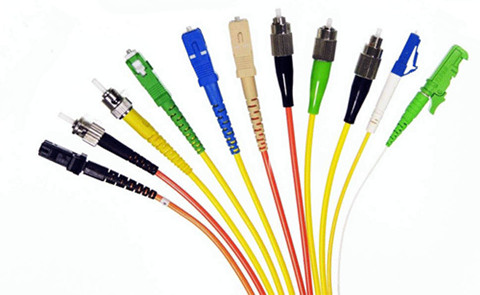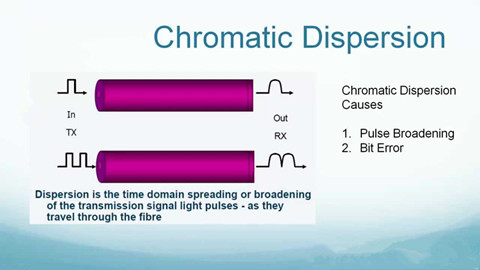Fiber optic technology has been utilized for many years in the telecommunication industry, consumers generally identify it with its high capacity for long-distance high-speed communications. However, over long-haul distance, the broadening of light pulses, called dispersion, is a critical factor limiting the quality of signal transmission over optical links. In this blog, we discuss about the optical fiber and its advantages, more importantly the causes and effects of chromatic dispersion.
Definition of Fiber Optics
Optical fiber is new medium, in which information (voice, data or video) is transmitted through a glass or plastic fiber, in the form of light, following the transmission sequence. Information is encoded intoelectrical signals. Electrical signals are converted into light signals. Light travels down the fiber. A detector changes the light signals into electrical signals. Electrical signals are decoded into information. Figure 1 shows fiber patch cables terminated with different connectors.
Optical fiber is new medium, in which information (voice, data or video) is transmitted through a glass or plastic fiber, in the form of light, following the transmission sequence. Information is encoded intoelectrical signals. Electrical signals are converted into light signals. Light travels down the fiber. A detector changes the light signals into electrical signals. Electrical signals are decoded into information. Figure 1 shows fiber patch cables terminated with different connectors.

Chromatic Dispersion
Chromatic dispersion (CD) is caused by the fact that single-mode glass fibers transmit light of different wavelengths at different speeds. It is a phenomenon that is an important factor in fiber optic communications. The result is a spreading, or dispersion, of the on-off light pulses that convey digital information.
Chromatic dispersion (CD) is caused by the fact that single-mode glass fibers transmit light of different wavelengths at different speeds. It is a phenomenon that is an important factor in fiber optic communications. The result is a spreading, or dispersion, of the on-off light pulses that convey digital information.
What Causes Chromatic Dispersion
There are two factors that cause chromatic dispersion: material dispersion and waveguide dispersion. The material dispersion occurs because the refractive index changes with the optical frequency. It is generally the dominant contribution, except in the wavelength region in which it vanishes (for silica based material this happens around 1300 nm). The waveguide dispersion depends on the dispersive properties of the waveguide itself. From a practical point of view, a significant property is that the waveguide dispersion has opposite signs with respect to the material dispersion in the wavelength range above 1300 nm.
There are two factors that cause chromatic dispersion: material dispersion and waveguide dispersion. The material dispersion occurs because the refractive index changes with the optical frequency. It is generally the dominant contribution, except in the wavelength region in which it vanishes (for silica based material this happens around 1300 nm). The waveguide dispersion depends on the dispersive properties of the waveguide itself. From a practical point of view, a significant property is that the waveguide dispersion has opposite signs with respect to the material dispersion in the wavelength range above 1300 nm.

Chromatic dispersion is a serious consideration in long-haul optical fibers. Its effect is essentially to stretch or flatten the initially sharply-defined binary pulses of information. This degradation makes the signals (1s and 0s) more difficult to distinguish from each other at the far end of the fiber. The result is that at any given length, the effective information capacity, or bandwidth, of the fiber optic cable can be significantly reduced. Special care must be taken to compensate for this dispersion so that the optical fiber delivers its maximum capacity.
Dispersion Compensation
Chromatic dispersion becomes a major consideration and must be accounted for when developing or deploying fiber optic equipment for use in telecommunications, cable TV, or other high-speed optical networks. So a length of dispersion compensation fiber can be added to a link, usually at a repeater (optical amplifier) that reverses the CD of the fiber span before it.
Chromatic dispersion becomes a major consideration and must be accounted for when developing or deploying fiber optic equipment for use in telecommunications, cable TV, or other high-speed optical networks. So a length of dispersion compensation fiber can be added to a link, usually at a repeater (optical amplifier) that reverses the CD of the fiber span before it.
And fortunately, techniques have been developed that help compensate for the negative effects of chromatic dispersion. One method involves pre-compensating the signal for the anticipated dispersion before it's sent down the optical fiber. Another method calls for using dispersion compensating fiber at the end of a length to correct or reverse the dispersion that was realized as the signal traversed the optical fiber. As a result, these techniques are widely used to help solve the problem of chromatic dispersion.
Conclusion
Fiber optic technology is the new trend in communications industry and is steadily and effectively replacing the copper wire system for transmission of signals. Chromatic dispersion in optical fibers can be avoided by using smaller core diameters which allows fewer modes. And the use of single-mode fiber permits no modal dispersion. Fiberstore offers fiber optical patch cables terminated with LC/SC/ST/FC/MTRJ/MU/SMA connectors on both ends, such as LC to LC fiber patch cable, LC-LC patch cord, LC fiber cable, LC-SC fiber patch cable, SC to SC fiber patch cable, LC-ST patch cable, LC to ST patch cable, etc.
Fiber optic technology is the new trend in communications industry and is steadily and effectively replacing the copper wire system for transmission of signals. Chromatic dispersion in optical fibers can be avoided by using smaller core diameters which allows fewer modes. And the use of single-mode fiber permits no modal dispersion. Fiberstore offers fiber optical patch cables terminated with LC/SC/ST/FC/MTRJ/MU/SMA connectors on both ends, such as LC to LC fiber patch cable, LC-LC patch cord, LC fiber cable, LC-SC fiber patch cable, SC to SC fiber patch cable, LC-ST patch cable, LC to ST patch cable, etc.
评论
发表评论